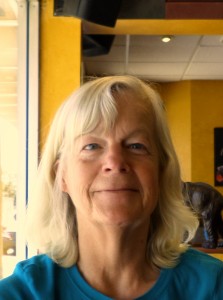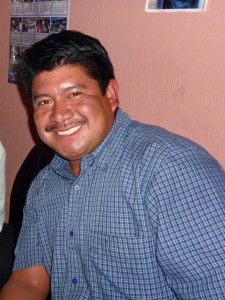

This article was prepared by Eduardo Jimenez, (right) Coordinator of Association Grupo Cajolá in Cajolá (voluntary position) and Municipal Director of Planning, and Caryn Maxim, (left)North American Coordinator of Grupo Cajolá
A letter from Grupo Cajolá, Guatemala
Grupo Cajolá is a group of Guatemalans and friends of Guatemalans, mostly from the town of Cajolá in the department of Quetzaltenango in Guatemala, and most of us are Maya Mam. (The Mam people are one of the four largest groups of Maya people now living in Guatemala.) Many of us have had to migrate to the United States out of necessity — to earn money for food, medical care, school, or housing for our families. Nearly 94% of Cajolá is poor, and nearly 40% of us live in the United States. We have organized ourselves to watch out for each other, especially during hard times, such as when someone dies, or gets sick. Some of us have returned to Guatemala, to Cajolá, and we are working there to organize the community to develop opportunities for a better life so that no one has to leave his family and community behind in order to survive. For more information go to www.grupocajola.org.
Gang Activity in Cajolá, Quetzaltenango, Guatemala
QUESTIONS REGARDING GANGS:
What are the gangs present in Cajolá? Have you heard of the Vatos Locos also known as Los Vatos Locos, or Los Batos Locos?
There are three gangs present in Cajolá, Sureños, Los Vatos Locos, and Raperos. When members of these gangs were deported from the US they began their own cells in Cajolá. They do not have any relationship with other cells, either in the US or in Guatemala. Each gang has approximately 50 members who are Cajolá indigenous youth.
Are they nationwide? Are they part of a larger group, like the 18 or MS13 or any other group?
There are cells of these gangs all over Guatemala, but they work as independent cells and do not act or affiliate with other cells. They do not have any relationship with the 18 or MS13.
Are there any documents/reports/etc re the Vatos Locos and their criminal activity?
We do not know of any.
Do they dress in a certain way?
No. Each group has its norms, whether loose pants or tight pants, but not recognizable on the street as a gang member.
Do they carry weapons? What kind?
They carry knives and chains. Sometimes they carry homemade guns.
What are some of their characteristics?
They steal from businesses, stores, churches, and individuals, as well as extort from young people, either students or workers. They use thinner to get high, and they drink alcohol. They target anyone that is weaker than them…such as a drunken man. They do not attack someone who seems more powerful, such as the Ladinos, a strong man, etc.
Who do gangs target? Do gangs target youth?
The gangs target other Cajolá youth to be members, particularly those that are not studying.
Do they specifically target a certain group of young boys? Do they go after indigenous youth? Do they use the fact that someone is indigenous in recruitment?
Cajolá is 97% indigenous. All the gang members are indigenous. They recruit other indigenous youth. They do not recruit Ladino (mixed race) youth.
What happens to youth who refuse to join?
They are punished, beaten up, and persecuted on an on-going basis. One young man was assassinated last year.
QUESTIONS ABOUT POLICE/LAW ENFORCEMENT:
How are laws enforced in Cajolá?
Cajolá does not have a state police force (the town evicted the police during the civil war for kidnapping the citizens.) There is a traditional community voluntary police force which is recruited annually among young men. The young men serve for 7 day periods, 24 hours/day, once per month for one year to maintain peace in the community, mediate domestic or other disputes. When a crime occurs they call the state police who are in the next town.
Does law enforcement respond to victims of gang activity?
No.
Does law enforcement protect the indigenous people as equally as non-indigenous people?
The local law enforcement, the voluntary community police, is also indigenous. In fact, their authority stems from their indigenous status. Unfortunately, since they recruit their members each year among the young men – and it is a requirement to serve – the voluntary community police force includes gang members as well.
Are law enforcement officers Ladino or Maya, or both?
The state police are both Ladino and Maya.
Does law enforcement make efforts to protect/prevent against gang violence?
There are no efforts at present to protect or prevent against gang violence.
QUESTIONS REGARDING YOUTH LABORERS:
Is there a name for the subset of children who are child laborers (for money, outside the home)?
When children stop attending school they look for paid work outside the home, whether in construction, shoe polishing, carpentry, whatever. We are not aware of any special name for this subset.
Are they all, or almost all, indigenous?
Since 97% of Cajolá is indigenous, most of these young workers are indigenous.
Are they specifically targeted by the gangs for extortion or other reasons?
They are targeted because they probably have money, whereas the school students do not.
QUESTIONS ABOUT THE MILITARY DRAFTING YOUTH:
Is the military drafting youth currently?
There is no military draft at present.
What is the minimum age for military service? 18 years to enlist
Are they only recruiting Maya youth? There have been rumors circulating but there is no draft.
